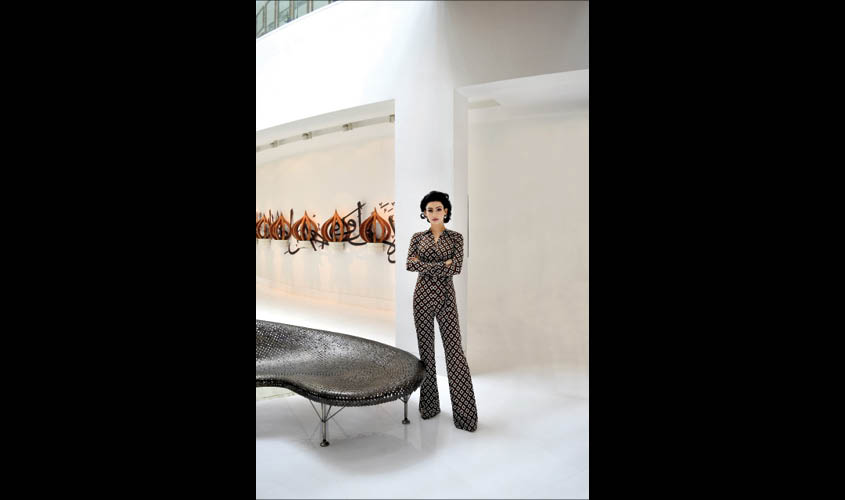Shalini Passi, who is ranked among India’s most prominent art patrons, speaks to Bhumika Popli about the cultural forums she has been associated with and her penchant for collecting artworks.
A Delhi-based art patron, Shalini Passi is known for her philanthropic projects and support programmes aimed at promoting Indian art. Through the Shalini Passi Art Foundation and MASH, and through her association with major cultural forums across the country, she continues to make significant contributions to the contemporary art scene. She spoke to Guardian 20 about her various projects.
Q. What should be the role of art patrons in our time?
A. As art patrons, it’s vital that we provide the necessary support to nurture and develop young artistic talent. We need to work together to develop an ecosystem that drives and promotes
Q. Could you tell us how the Shalini Passi Art Foundation is supporting and promoting Indian contemporary art?
A. In my philanthropic efforts, I aim to create a culture that values and admires creativity by focusing on education, access and support for talented emerging artists. Earlier this year I launched the MASH FICA award for new-media art, calling for open submissions from artists under 30. The main criteria: be bold. Through these awards, we aim to create platforms and pathways to build the initial steps for an artist’s career.
Q. At what point in your life did you become interested in the arts?
A.I have always been artistically inclined. I used to paint when I was in school and while in college. The first artwork that I acquired was from a fellow art student; a friend of mine had made a beautiful sketch of a portrait and I wanted that portrait, so I exchanged that with one of my landscapes. After that, my first serious acquisition was a work by M.F. Husain, which I thought was striking for its vivid and expressive mark-making.
Q. How can the art world reach out to a larger audience?
A. Art can be perceived as exclusive, which means it’s important to have interesting programmes to enable arts participation particularly outside of traditional art institutes, and by engaging the audience in performances and talks. This creates a less intimidating environment for people to learn to appreciate the arts.
Q. Initiatives like the Khoj International Artists Association and the Kochi-Muziris Biennale—both of which you’ve been associated with—how significant a role do they play in the cultural evolution of a society?
A. As an incubation space for alternative arts, providing financial support and both physical and intellectual space for artists to develop their work, Khoj plays a central role in the development of experimental, interdisciplinary and critical contemporary art practice in India, constantly challenging the established thinking about art. Similarly, the Kochi–MuzirisBiennale provides grassroots support of new and experimental art practices. It’s often referred to as the “People’s Biennale”, created to open up an artistic appreciation for all, and that is exactly what we seek to do through the Shalini Passi Art Foundation.
Q. You also run another foundation which goes by the name of MASH. What is the idea behind it?
A. MASH (My Art Shalini) is an online platform designed to broaden access to the arts. I established MASH so that people can discover art, architecture, craft, design and fashion from around the world; to give them greater exposure to different ways of thinking and styles of working, and hopefully spark off new ideas! It features topical articles, highlights emerging talent and engages in behind-the-scenes studio interviews with both established and interesting emerging artists.
Q. What are the top artworks in your collection? What is your approach to buying art?
A. One of my favourite artworks is Mrinalini Mukherjee’s piece,Kusum, made in 1996. In this piece, the artist transforms a simple everyday material, natural rope, into extraordinary sculptural forms. There are rich references in her work, with titles relating to mythology and folklore, while her exploration of sexuality and the body suggests a strong feminine perspective. She was one of a number of women artists whose work established that textiles and fibres which are traditionally associated with crafts could be just as important as the materials typically associated with fine art.
Another of my all-time favourite pieces is Anita Dube’s Theatre of Sade. The installation comprises objects that look like books or artificial dentures wrapped in black velvet and presented like theatrical props, abandoned after rehearsal. Through this work, the artist seeks to align herself with the libertine philosophy of the French writer Marquis de Sade, and the violent, perverse imagery of Sadian theatre, which, according to the artist, is about bondage and the triumph of will. Considering that the predominant feature of the Sadian experience is that of cruelty, Dube has tried to explore the psychology of the sensation of terror and its sociological impact.
Q. Tell us about your new initiatives and focus areas.
A. In line with the foundation’s mission to create a platform to encourage and promote emerging artists, we will be hosting a performance piece by Meera George on Monday, 13 May. Additionally, the foundation has planned a number of lectures by eminent speakers from a range of artistic disciplines, as well as a large-scale survey show which opens at the end of the year, and a symposium to take place in December. The foundation hopefully will participate in the India Art Fair and in India Design ID again in February 2020.

